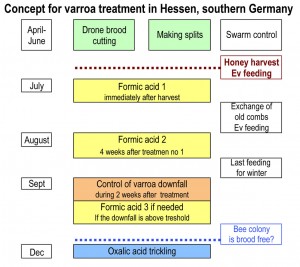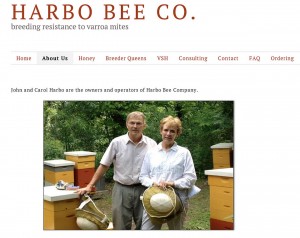The other day I received Imkerfreund 12-2013 in my postbox. In this issue of the German bee magazine I found an interview with the scientist leading a varroa breeding project involving beekeepers. It’s a project that has made some progress.
A German strategy
Germany has had varroa for about 40 years. And they mostly try to breed pure Carniolan bees (carnica) and pure Buckfast with the help of isolated mating stations (and insemination). The main varroa treatment concept is the following in the south of Germany.
- April-June Cut dronebrood and make splits
- July After harvest in July treatment with Formic acid
- August Four weeks later the second treatment with Formic
- September The third treatment with Formic if mite downfall after treatment no 2 is too high
- December Treatment with Oxalic acid, trickling of sugarsolution with oxalic
Their breeding program has two resistance parameters: pinkilling a square decimeter of brood (similar to freeze killed brood) and measuring the development of the varroa population during the season. Besides traits like low swarming, good temper and a honey crop. Their progress: being able to skip one of the summer treatments with Formic acid (as far as I understood the German article).
An American strategy
USA has had varroa for about 25 years. Few try to breed pure race bees like the Germans. Ineminated and naturally mated queens are used. The main varroa treatment concept for smaller operations are aimed at organic treatment (involving formic acid, thymol, drone cutting, hops) and treatment free (involving small cell size, topbar hives). Bigger operations most often trust different syntetic miticides, formic, thymol and hops.) Americans are more focused on treshold counts of mites for the time to treat.
The Russian bees from the very east of Russia, the Primorski area, is one quite succesful undertaking started and developed by the USDA. A number of beekeepers have formed an association to take care of the 18 lines of these bees. They are treated much less than ordinary bees against varroa. With these bees you have to watch out for swarming.
The VSH-bees are influencing most of the other efforts of breeding resistant bees to varroa mites. These bees are a mixture of all kind of bees. Here you find most of the traditional beekeepers that don’t use any treatment against varroa mites, for example John Harbo, http://www.harbobeeco.com/breeder-queens/ , and Adam Finkelstein, http://www.vpqueenbees.com/breeding.html
Beekeepers in different states are forming breeding organisations funded by the governement, like this one: http://mysare.sare.org/mySARE/ProjectReport.aspx?do=viewRept&pn=FNE12-737&y=2012&t=1
There are those in Europe forming good projects and those already not treating against varroa either, but with this article I want to get attention to how little progress is made with the strategy mentioned above in Germany and how great achievement is made with the VSH-breeding, focused at the start on one trait: VSH. Then on the other. Something has to be learnt here.
Actually resistant bees were achieved already after very few years, by Harbo and Harris in 1995-98 in USA. They started with survivor colonies of any type of bee they were given. The only one parameter they focused on first was VSH: Varroa Sensitive Hygiene. See other articles here in the VSH category. This development of resistant bees have to be done in all kind of regions differing in climatic and other local characteristics, mites and pathogens for example.
It’s time for Europe to learn the lesson and form breeding projects together with beekeepers where ’central’ areas are formed fairly isolated from other bees. All bee colonies in these ’small starter’ areas are part of the program. An effective way of using funding money from European Union would be to support such projects.


As a German I have of course to answer to Eriks contribution “Breeding for Varroa resistance: Germany versus USA”…:-).
When commenting about activities in the varroa resistance breeding area I guess it’s better to compare Europe versus US. Otherwise it would be too bad for Germany…
I think the main drawback for Europe compared to US is that a funded continuous breeding program is missing. The US seems to have at least 3 – Minnesota Hygienic Stock (MNHYG), Russian Honey Bee program (RHB) and VSH program, which all seem to have shown valuable outcomes. Moreover, the organic beekeeping community in the US, e.g. Ed and Dee Lusby, Michael Bush, Dennis Murrel and others have been innovative and could establish treatment free beekeeping since many years. And this could be achieved with local bee races or no complicated bee breeding scheme!!! Their impact with small cells, comb distance, not contaminated bee wax etc. is not only logic and inspiring, it works as stated above.
Europe did of course some funded scientific investigation of Varroa and could contribute to the understanding of infestation mechanism in the 90-ies, e.g. grooming behaviour (Bienefeld, Aumeier, Thakur etc.) or VSH (Rosenkranz, Vandame). However, efforts seem to be sporadic and as already mentioned not continuous, to yield in resistant queens that are distributed via the beekeeping community.
Besides, beekeeping organizations here I can only comment on Germany with the AgT (Arbeitsgemeinsschaft für Toleranzforschung) http://www.toleranzzucht.de/en/breeding-programme/, try to connect and coordinate different breeders in order to achieve bees that combine favourable and varroa resistant traits. However, improvement ratios seem to be small up to now.
But in my eyes Europe could contribute significantly by activities of bee breeders. The idea to use already varroa resistant bees for breeding was first established by Erik Österlund (1989) and John Keyfuss (1993), who cross African bees into A.mellifera mellifera/Buckfast. John uses a Tunisian bee (Apis mellifera intermissa) and Erik Apis mellifera monticola from Kenya. The resulting Elgon bee is since a bee that needs less or even no varroa treatment. The same is true for Keyfuss bees and he gain merits by bringing this topic into broad public interest with his “World varroa challenge”.
This approach was copied by Rinderer (RHB), who used Russian bees that lived since 200-250 years with varroa mites and hence, should have developed resistance traits. The same idea was practically followed by P. Jungels (Buckfast – Primorski mixes) and J. Koller (pure Primorski) (Primorski synonyme for russian bees) in Europe, who contributed significantly by providing varroatolerant queens to the European bee keepers.
A guy that use local (carnelian) bees for his breeding program is Alois Wallner from Austria http://www.voralpenhonig.at/, who bred since 1990 for bees that groom and kill varroa mites by removing their legs. The result is now a bee that kill nearly every mite (varroa killer factor 100). Additionally his bees express VSH behaviour and hence, bees need only few or no treatment with formic acid.
In my opinion one brave European guy need to be mentioned as well which is Juhani Lunden in Finland http://www.saunalahti.fi/lunden/varroakertomus.htm He managed in a brute force approach to breed varroaresistant bees, which are not treated since 2009. He used a strong selective pressure to achieve his goal and hence, other traits as gentleness or honey crop might be compromised.
So taken together, these efforts need to put on a strong base in Europe as well and both, the spread of “resistant genes” by suitable queens and by suitable programs need to be pushed and furthermore the usage of organic beekeeping principles that result in treatment free bees should be distributed. That includes the courage of not using treatments to outselect non optimal strains. Here the community in Europe is already on the way see http://resistantbees.com/ (Germany and Spain), but Europe should definitely speed up and learn the positives from the US. This is especially true for the scientific sector and funded EC programs.
Thanks Rüdiger for this excellent summary. I made the post purposely provocative to get some response and hopefully debate. Of course you are right! But as you say in your comment, Koller was starting something interesting with the Russian bees but couldn’t continue for different reasons. Wallner has another strategy that seems to be the only one up till now that I know of that is successful in Germany. Is he still active?
I made the “Germany versus USA” approach to focus on exactly what you are saying in your comment. Thanks again. But when looking on the whole of Europe the picture becomes better for us on this side of the Atlantic. Good that you mention all those engaged people helping the beekeeping community through their work, both in Europe and USA. Canada is coming too.
Dear Eric,
I suspect your intention….:-) and thanks for the flowers. As a beginner in this area I feel honoured by your comment.
Both Wallner and Koller are active. I have talked to Wallner this morning and he claimed that he managed to bred Carnolians with 100% killerfactor by now, which means all the mites that are found below the hive have removed legs. I was wondering whether this is the only resistant trait in that bees and he answered no they show VSH as well. (which is a little bit a pity, from a scientific point of view, because pure grooming trait would be not bad….)
But he will publish a report about the last years in his breeding efforts in the Austrian Bee Journal. By the end of January this report will be on his homepage. If you want me to translate this report let me know….
And Wallner is active as well. He sells Elgons and Primorskis and is one of the most active breeders in Germany on this topic.
Hello Rüdiger
But your’e not a beginner in using the language.
Though I guess you meant Koller and not Wallner in the last paragraph?
Yes, of course I’m interested in a translation of the results of Wallner, both in English and in Swedish.:)
Eric,
you are right I mean Koller in the last paragraph.
I had some scientific education and worked some years at german research institutes. However, since a while I moved to industry and now I’m getting heavily infected by the “bee virus”…:-)
Hallo , i have some Queens ( Primorski and Elgon ) from Koller from Last Year and this Year, but i was thinking Koller dont have carnolians bees . In any Way i think that Koller is doing a very good work for all of us.